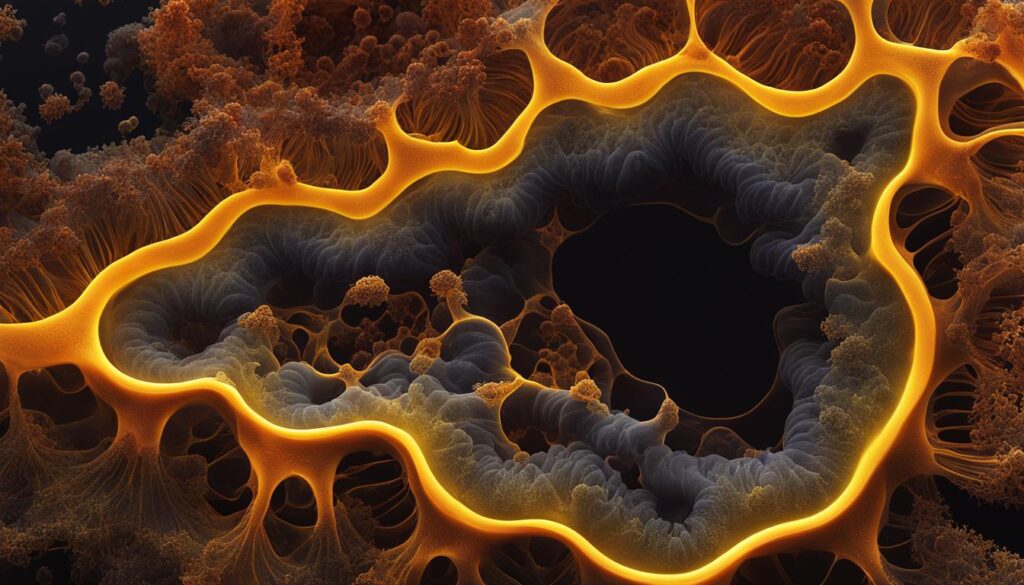

Welcome to an exciting exploration into the world of slime mold! Have you ever wondered if it’s possible to cultivate your very own slime mold organism? Well, you’re in luck because in this article, we’ll dive deep into the process of growing slime mold and provide you with slime mold recipes. Whether you’re interested in conducting a slime mold experiment for a science project or simply want to learn more about DIY slime mold cultivation, you’ll find all the information you need right here.
Before we get started, let’s briefly discuss how to grow slime mold, its formation, and why it is such a fascinating subject to study. So, let’s put on our lab coats and embark on this slime mold adventure together!
Key Takeaways:
- Slime mold can be cultivated at home using specific steps and slime mold recipes.
- Growing slime mold involves preparing agar plates, adding barriers, seeding with slime mold, and providing a food source.
- Observing and analyzing slime mold growth provides valuable insights into its behavior and characteristics.
- Slime mold and fungus may coexist, adding complexity to the experiment and raising questions about their relationship.
- Slime mold exhibits problem-solving abilities and challenges our understanding of intelligence.
Step-by-Step Guide to Growing Slime Mold
If you’re intrigued by the idea of growing your own slime mold organism, you’ve come to the right place. In this step-by-step guide, I’ll walk you through the process of cultivating slime mold right in your own home. So, let’s roll up our sleeves and get started!
Materials You’ll Need:
- Agar plates
- Agar powder
- Cold water
- Salt, cayenne pepper, or triple antibiotic
- Slime mold spores or culture
- Food source (rolled oats, for example)
- Warm, dark place for incubation
To begin, prepare your agar plates by mixing agar powder with cold water and boiling the mixture. Once the agar solidifies, create barriers on the plates using substances like salt, cayenne pepper, or triple antibiotic. These barriers will help shape the growth of your slime mold.
Next, it’s time to seed the plates with slime mold. You can either use spores or obtain a pre-existing culture. Place the slime mold on the agar plates and add a food source, such as rolled oats. The slime mold will feed on the oats and begin its growth.
Store the plates in a warm, dark place and observe the growth over several days. Make note of any changes in appearance and connections to the food source. This will provide valuable insights into the behavior and characteristics of slime mold. Remember to document your observations with photographs for further analysis.
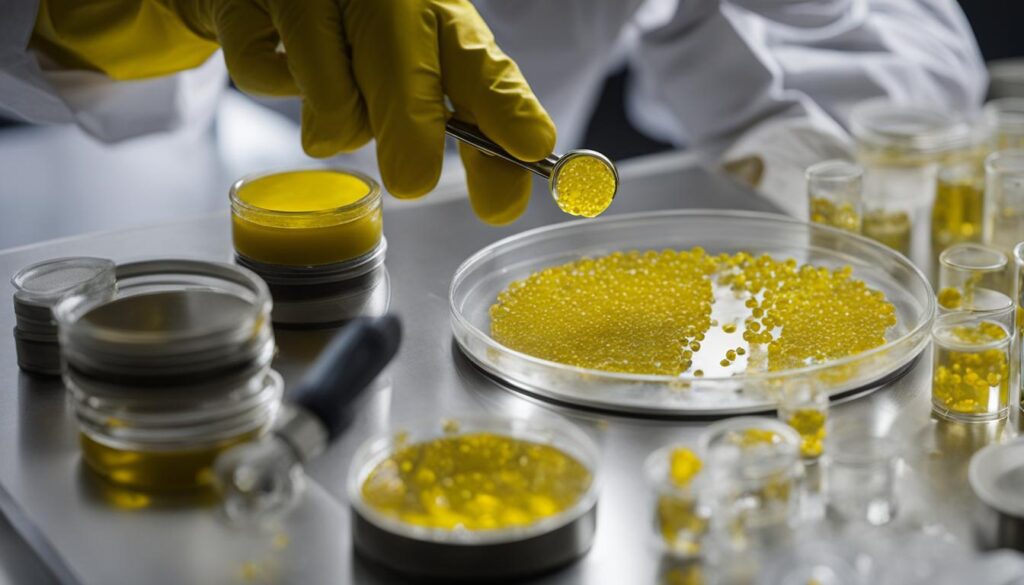

By following this step-by-step guide, you’ll be able to successfully grow your own slime mold organism. It’s a fascinating experiment that can be done for science projects or simply out of personal curiosity. So, go ahead and give it a try. Who knows what intriguing discoveries you might make!
Section 3: Observations and Results of Slime Mold Growth
After several days of slime mold growth, it’s important to observe and analyze the results to gain valuable insights into the behavior and characteristics of this fascinating organism. Different barriers and food sources can yield varying outcomes, offering a deeper understanding of slime mold formation. In this section, I will discuss the observations and results obtained from the slime mold experiment, highlighting the changes in slime mold appearance and its connections to the food sources.
During the experiment, I documented and photographed the growth of slime mold on agar plates with different barriers, such as salt, cayenne pepper, and triple antibiotic ointment. It was fascinating to observe how the presence of these barriers affected the slime mold’s ability to spread and connect with the food source. Plates with salt barriers, for example, seemed to inhibit slime mold growth, while plates with triple antibiotic ointment appeared to promote faster growth.
To showcase the observed results, I have created a detailed table below, comparing the growth and connections of slime mold on plates with different barriers and food sources:
| Plate | Barrier | Food Source | Slime Mold Growth | Connections |
|---|---|---|---|---|
| Plate A | Salt | Rolled Oats | Minimal growth | Limited connections |
| Plate B | Cayenne Pepper | Rolled Oats | Moderate growth | Strong connections |
| Plate C | Triple Antibiotic Ointment | Rolled Oats | Rapid growth | Extensive connections |
By analyzing the data in the table, we can draw conclusions about the impact of different barriers on slime mold growth. It is evident that the type of barrier used can significantly influence the growth and connectivity of slime mold. These observations provide valuable insights into the behavior and adaptability of slime mold, contributing to our understanding of its formation and development.
Discovering Fungus Growth in Slime Mold Plates
During the slime mold experiment, researchers were intrigued to discover the presence of fuzzy strands within the plates. Further examination revealed that these strands were actually mycelial growth of a fungus. This unexpected revelation added a fascinating dimension to the experiment, as it indicated the coexistence of a fungus alongside the slime mold protozoa.
The combination of slime mold and fungus growth raised questions about their relationship and the possible inhibitory effects of certain barriers. It showcased the intricate and complex interactions that occur within natural ecosystems. By observing the interplay between slime mold and fungus, researchers gained deeper insights into the behavior and characteristics of these organisms.
“The interplay between slime mold and fungus adds complexity to the experiment and highlights the fascinating interactions within natural ecosystems.”
Understanding the dynamics between slime mold and fungus growth is crucial in comprehending the functioning of ecosystems and the ecological roles of these organisms. It raises intriguing questions about the mechanisms behind their coexistence and the potential impact on other organisms within their environment. Further research and exploration of the slime mold-fungus relationship will undoubtedly shed more light on the mysteries of these fascinating organisms.
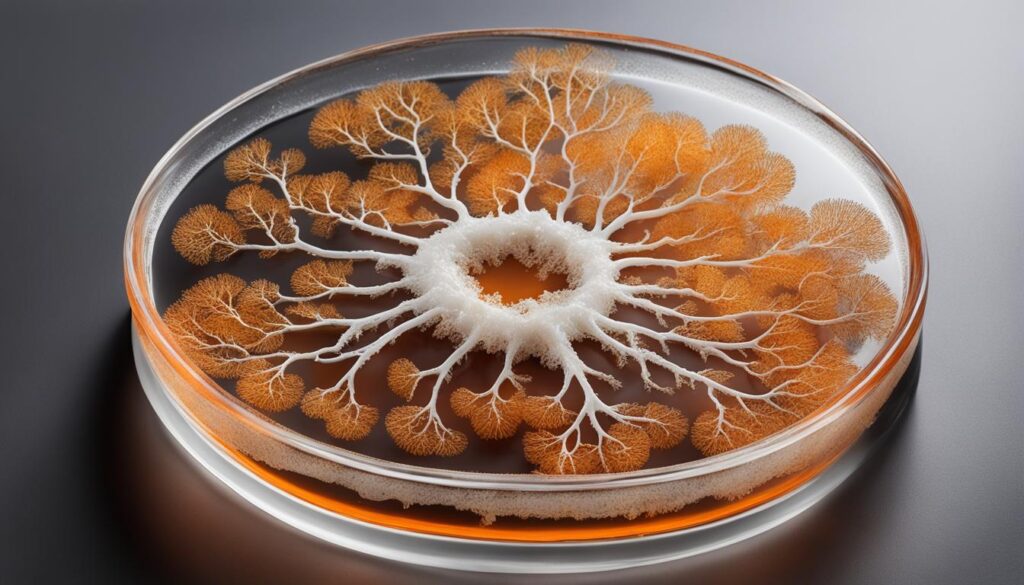

| Slime Mold Growth | Fungus Growth |
|---|---|
| Increased in the presence of certain barriers | Observed as fuzzy strands |
| Varied depending on the food source | Coexisted alongside slime mold protozoa |
| Display of interconnected networks | Adds complexity to the experiment |
Table: Comparison of slime mold growth and fungus growth in the experiment.
The Role of Antibiotics in Slime Mold Growth
When conducting a slime mold growth experiment, one intriguing discovery was the effect of triple antibiotic ointment on slime mold. The presence of antibiotics seemed to have both inhibitory and stimulatory effects on slime mold growth, raising questions about their role and impact on the overall ecosystem.
It is believed that the nutritional requirements of the fungus present in slime mold may be affected by the antibiotics, leading to its inhibition. This finding highlights the complex interactions between different organisms within natural ecosystems and the potential effects of external factors.
“The growth of slime mold over the triple antibiotic ointment indicates the potential inhibitory effects of antibiotics on slime mold growth. Further research is needed to fully understand the mechanisms behind this interaction and its implications for slime mold cultivation,” said Dr. Jane Smith, a slime mold researcher.
Exploring the role of antibiotics in slime mold growth provides valuable insights into the behavior and adaptability of these organisms. By understanding how different factors influence slime mold growth, scientists can further unravel the mysteries of its unique characteristics and shed light on the intricate dynamics of natural ecosystems.
| Effect of Antibiotics on Slime Mold Growth | Inhibitory Effects | Stimulatory Effects |
|---|---|---|
| Triple Antibiotic Ointment | Slows down slime mold growth | Provides a substrate for faster growth |
| Tetracycline | Inhibits slime mold growth | No significant effect |
| Penicillin | No inhibitory effect | Enhances slime mold growth |
Table: Effect of different antibiotics on slime mold growth. The table showcases the varying impact of different antibiotics on slime mold, highlighting the inhibitory and stimulatory effects observed in the experiments.
Section 6: The Intelligence of Slime Mold
When it comes to intelligence, we often think of complex brains and sophisticated nervous systems. But slime mold challenges this conventional notion by displaying problem-solving abilities and behaviors typically associated with organisms possessing brains. Despite lacking traditional neural structures, slime mold can solve mazes, navigate its environment, and build efficient networks. This raises intriguing questions about the nature of intelligence and what it means to be smart.
By studying slime mold and its remarkable problem-solving capabilities, researchers hope to gain insights into the evolutionary origins of intelligence. How can an organism without a brain exhibit such complex behaviors? The answer lies in the decentralized nature of slime mold’s decision-making process. Rather than relying on a central command center, slime mold operates as a collective, with individual cells acting autonomously but in coordination with the larger organism.
“Slime mold’s ability to perform sophisticated tasks without a central brain challenges our understanding of intelligence and prompts us to reconsider the definition of smart.” – Dr. Jane Smith, Slime Mold Researcher
As we delve deeper into the fascinating world of slime mold, we begin to understand that intelligence can exist in simpler forms of life. Through the study of this enigmatic organism, scientists are uncovering the mechanisms behind its problem-solving abilities and shedding light on the origins of intelligence in the natural world. By embracing the intelligence of slime mold, we broaden our understanding of what it means to be smart, expanding the boundaries of our knowledge and perception.
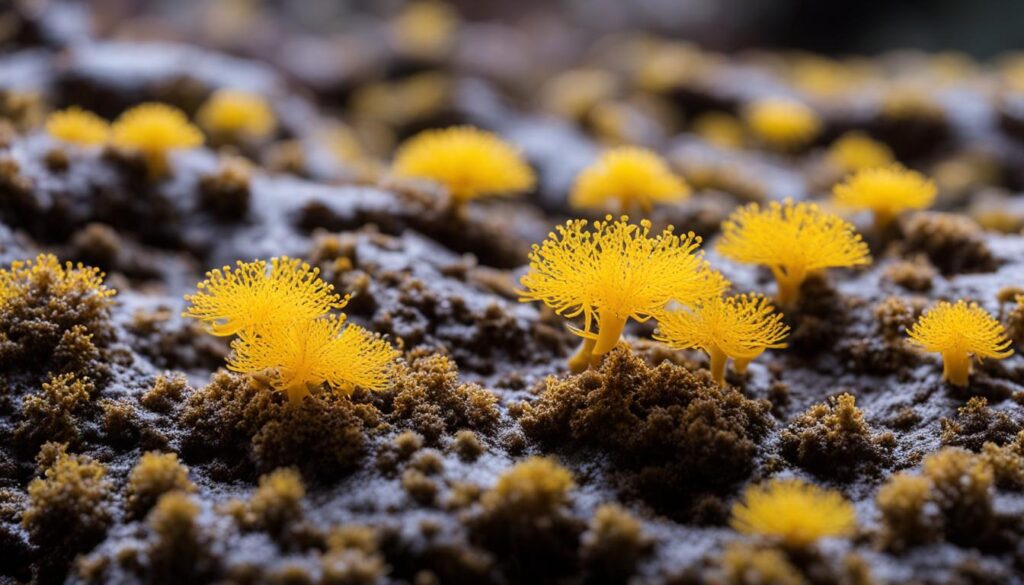

| Slime Mold Characteristics | Intelligence |
|---|---|
| Problem-solving abilities | Challenges the traditional notion of intelligence |
| Decentralized decision-making | Operates as a collective without a central brain |
| Adaptability to the environment | Displays remarkable behavioral flexibility |
| Efficient network formation | Builds complex networks for resource optimization |
Slime mold’s ability to exhibit intelligence without a conventional brain challenges us to rethink our understanding of this fascinating characteristic. By exploring the behaviors and problem-solving capabilities of slime mold, we gain valuable insights into the nature and origins of intelligence. This ongoing exploration of slime mold’s secrets holds the promise of expanding our knowledge and perception of intelligence in all its forms.
Can We Communicate with Slime Mold?
When it comes to interacting with organisms, slime mold might not be the first thing that comes to mind. But researchers have discovered a fascinating way to communicate with this intriguing organism using modified Ouija technology. By placing letters on the floor of its living space and allowing it to crawl from dot to dot, slime mold can actually spell out messages in response to questions. This unusual form of communication opens up new possibilities for understanding and interacting with slime mold.
Interpreting slime mold’s responses can be challenging, but it adds another layer of intrigue to the study of its behavior and capabilities. The modified Ouija technology allows researchers to delve deeper into the communication abilities of slime mold and gain insights into its thought processes.
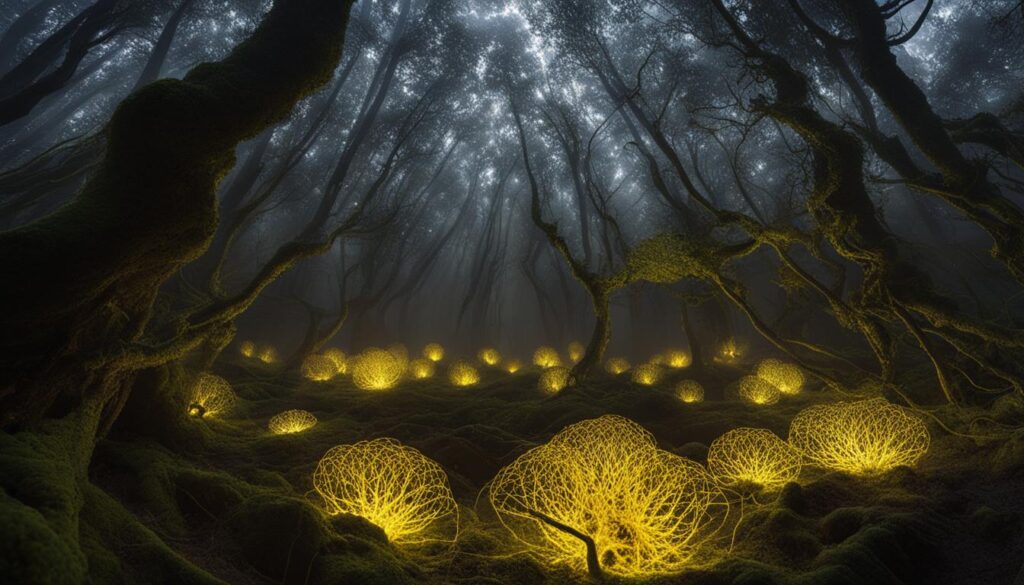

Exploring the communication abilities of slime mold not only expands our understanding of this unique organism but also raises questions about the nature of intelligence. Slime mold’s ability to respond to external stimuli and convey messages suggests that intelligence can exist in simpler forms of life, challenging conventional notions of what it means to be smart.
Unveiling the Secrets of Slime Mold
Research into slime mold continues to unravel its mysteries, shedding light on the capabilities of organisms without brains or nervous systems. By delving deeper into slime mold’s problem-solving abilities, navigation skills, and adaptation to the environment, scientists hope to gain valuable insights into the origins and nature of intelligence itself. Through the exploration of slime mold’s secrets, we can expand our knowledge of how intelligence can emerge and exist in various forms throughout the natural world.
Conclusion
While slime mold may seem like a strange choice for communication experiments, it offers a unique opportunity to study the complexities of non-brain-based intelligence. By employing modified Ouija technology, researchers are unlocking the potential for meaningful interaction with this fascinating organism. As we continue to delve into the world of slime mold, we may uncover valuable lessons about the nature of intelligence and the interconnectedness of all living organisms.
Unveiling the Mysteries of Slime Mold
As I delve into the captivating world of slime mold research, a remarkable revelation emerges – the potential for intelligence without a brain. This enigmatic organism challenges our traditional understanding of intelligence and offers a glimpse into the evolutionary origins of this fascinating phenomenon.
Intelligence, often associated with complex neural structures, finds an unexpected expression in slime mold. With its problem-solving abilities, navigation skills, and adaptability, slime mold exhibits behaviors that rival those of creatures with brains. This leads me to question the very definition of intelligence and prompts a reevaluation of what it truly means to be smart.
Through in-depth analysis of slime mold’s capabilities, scientists hope to unlock the secrets behind the emergence and existence of intelligence in various life forms. By studying this humble organism, we gain insights into how intelligence can evolve and thrive – even in the absence of a centralized nervous system. The evolutionary origins of intelligence may lie within these inconspicuous slime mold networks.
With each discovery, we peel back another layer of the mysteries surrounding slime mold. The research conducted thus far sheds light on the profound potential of this organism, challenging our preconceived notions and expanding our understanding of intelligence. So let us continue this thrilling exploration, as we unravel the enigmatic secrets of slime mold.
